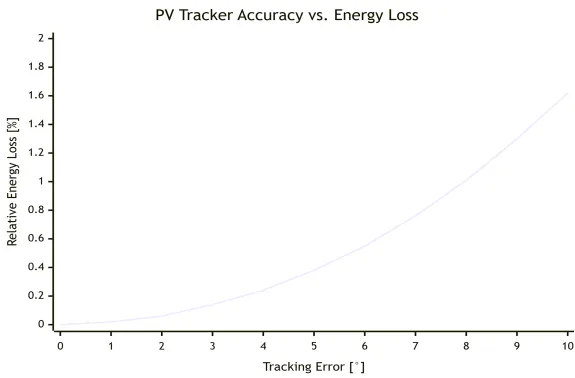How accurate is a solar tracker?
By Lee Liu | September 2, 2025
A solar tracking system is a device that adjusts the angle of PV panels according to the sun’s trajectory. While it’s widely known that solar trackers can increase energy yield, one critical metric often goes unnoticed: precision.
The optimal angle for PV panel power generation is perpendicular to sunlight. Any deviation from this angle reduces the effective irradiance received by the panel, thereby lowering its output. In large-scale solar power plants, even minor losses per panel can accumulate into significant losses. Therefore, the precision of solar trackers is typically controlled within ±2°.
Standard and Precision
The IEC has issued the IEC 62817 standard, which provides a reference for solar tracker accuracy. According to this standard, in order to effectively capture the majority of available direct sunlight, the precision of solar trackers must be within ±5°, allowing for the capture of 99.6% of usable direct solar energy.
In practice, most solar trackers aim for even greater precision, typically achieving ±2°. This higher accuracy translates into improved energy yield and greater economic returns.

Algorithms and Precision
The precision of a solar tracker is largely determined by its control algorithm.
- Astronomical Algorithm: This method calculates the sun’s position in the sky based on known astronomical data such as latitude, longitude, and time. It then drives the tracker accordingly. It’s advantages include high accuracy, stability, and independence from weather conditions, theoretical precision can reach within 1°.
- Photosensor Algorithm: This approach uses light sensors to detect real-time light intensity and adjusts the tracker to the point of strongest illumination. It performs well under diffuse light conditions such as cloudy or overcast weather. However, factors like sensor placement, dust accumulation, and directional light intensity differences can affect its accuracy, which typically ranges from ±1° to ±2°.
Mechanisms for Precision Control
Beyond algorithms, achieving high tracking precision in solar tracking systems requires multiple engineering mechanisms.
- High-Precision Sensors: Using high-precision encoders or angle sensors enables more accurate feedback on the solar tracker’s actual position.
- Closed-Loop Control Systems: These systems compare the actual position with the target position and continuously correct deviations through feedback loops, minimizing error.
- **Mechanical Structure: ** Precision transmission mechanisms (e.g., slewing drives, gear reducers) and high-rigidity structural designs help reduce backlash and deformation, thereby lowering mechanical error.
- Wind Load Control: During high wind conditions, the solar tracker automatically adjusts to a horizontal or wind-safe angle to protect the equipment. Although this temporarily sacrifices energy output, it ensures system precision and safe operation.
Conclusion
It’s important to note that improving precision can significantly increase costs. For example, using higher-precision sensors and more sophisticated mechanical components may cost several times more than standard parts. In applications, designers must strike a balance—choosing a level of precision that meets energy yield requirements while maintaining cost-effectiveness. For ground-mounted solar plants, a precision range of ±1° to ±2° is commonly selected, as it offers the best trade-off between performance and cost.
In summary, the precision of solar tracking systems is not just a technical specification—it directly reflects the efficiency of PV power generation and the profitability of the project. With the integration of intelligent forecasting, meteorological data, and AI algorithms, real-time tracking precision will continue to improve. Leveraging IoT technologies also makes fault diagnosis and self-calibration more accessible, helping to resolve potential precision issues. These ongoing technological advancements will drive even greater energy returns from solar tracking systems.
